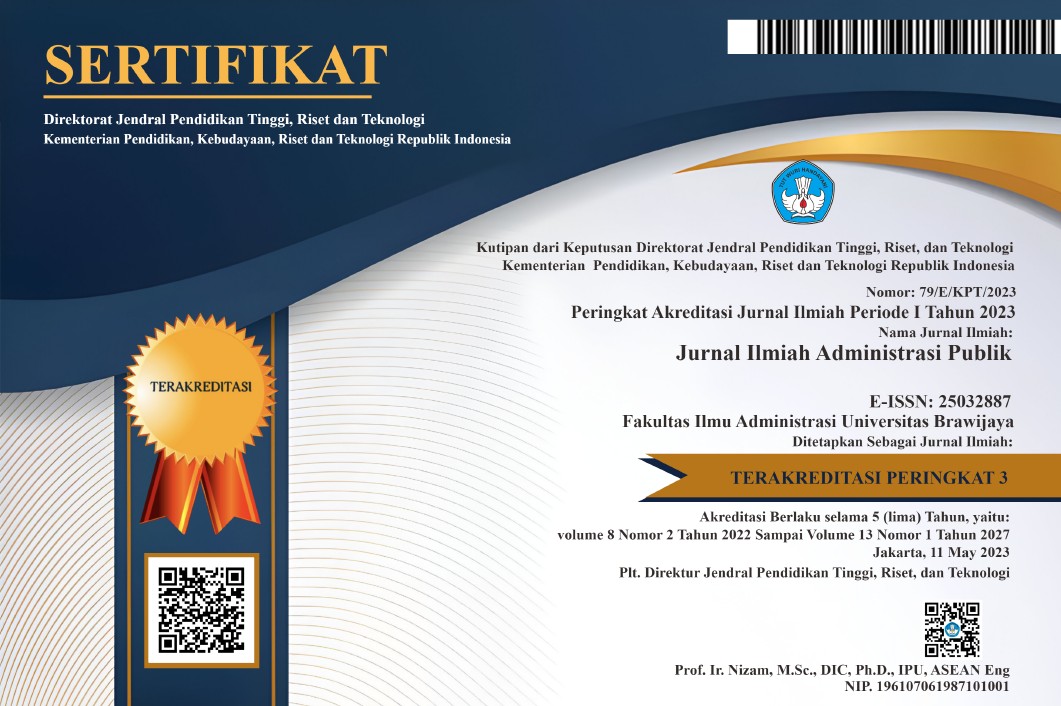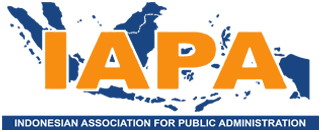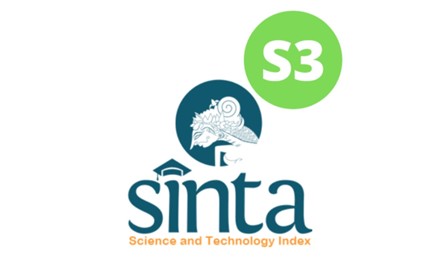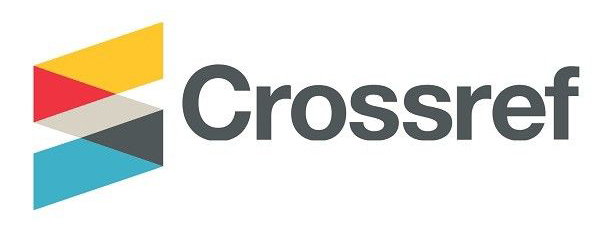Implementation of Bank Indonesia CSR Program on Empowerment the Micro, Small, Medium Enterprises (MSMEs) (Study at the Artisans of Tenun Ikat Bandar Kidul, Kediri City, East Java)
DOI:
https://doi.org/10.21776/ub.jiap.2016.002.04.13Keywords:
Bank Indonesia CSR Program, empowerment, MSMEs, artisansAbstract
Kediri City is famous with product of “Tahu Kuning&Takwaâ€. But, Kediri Cityhas other potential that can be developed to encourage the local economic
development is Woven Home Industry Tenun Ikat. Nowadayas, the existence of Tenun Ikat Bandar Kidul product was less unknown in the market. It encourages Bank Indonesia to take a part on empowerment them to be survive in competition era. This research aimed to analyze the implementation of Bank Indonesia CSR Program to empower the artisans. The result revealed that the commitment, communication, and support among stakeholders such as: Bank Indonesia, Local Government and artisans were not good enough to success the CSR program from Bank Indonesia.
References
Agyapong, Daniel. (2010). Micro, Small and Medium Enterprises’ Activities, Income Level and Poverty Reduction in Ghana – A Synthesis of Related Literatureâ€. International Journal of Business and Management, 5, (12), pp.196-205.
Agyapong, Daniel. (2011). Criteria for Assessing Small and Medium Enterprises’ Borrowers in Ghana. International Business Research, 4,(4), pp.132-138.
Al Haddad. (2011). The Effect of Corporate Governance on the Performance of Jordanian Industrial Companies: An empirical study on Amman Stock Exchange. International Journal of Humanities and Social Science. 1,(4), pp.55-69.
Bligiardi. (2011). Innovative Characteristics of Small and Medium Enterprises. Journal of Technology Management&Innovation, 6, (2), pp.83-93.
Brown, et al. (2001). Measuring Capacity Building. Available at http://www.issat.dcaf.ch/download/19139/225563/ [Accessed July 20th, 2016].
Chambers, R. (1995). Poverty and Livelihood: Whose Reality Count ?: People From Improverishment to Empowerment. New York: New York University Press.
Creswell, J. W. (1994). Research Design: Qualitative And Quantitative Approaches. Thousand Oaks, CA: SAGE Publications.
D’Amato. (2009). Corporate Social Responsibility and Sustainable Business : A Guide to Leadership Tasks and Functions. Available at http://www.insights.ccl.org/wpcontent/uploads/2015/04/CorporateSocialResponsibility.pdf. [Accessed 20th, 2016].
Edward III, George C. (1980). Implementing Public Policy. Washington DC: Congressional Quarterly Press.
Elkington, J. (1997). Cannibals with Forks: The Triple Botton Line of 21st Century Business. Oxford, UK: Capstone.
Erstad, Margaret. (1997). Empowerment and Organizational Change. International Journal of Contemporary Hospitality Management, 9,(7), pp.325–333.
Felicio, et al. (2012). Human Capital And Social Capital In Entrepreneurs and Managers of Small and Medium Enterprises. Journal of Business Economics and Management, 13,(3), pp.395–420.
Ife, Jim. (1995). Community Development. Australia: Longman Australia Pty. Ltd.
Jasra. (2011). Determinants of Business Success of Small and Medium Enterprises. International Journal of Business and Social Science. 2,(20), pp.274-280.
Jupp and Ali. (2010). Measuring Empowerment? Ask Them. Quantifying Qualitative Outcomes From People’s Own Analysis. Available at https://www.oecd.org/countries/bangladesh/46146440.pdf./ [Accessed July 1th, 2016].
Hariyono. (2015). The Analysis of Business Decision for the Development Basic of Community Entrepreneurial Training Model at Tenun Ikat Craft Center Bandar Kidul Kediri. IOSR Journal of Business and Management, 17,(11), pp.133-140.
Hayami, F. (2009). Overview of Social Cognitive Theory and Self-efficacy. International Journal of Management. 12, (1), pp.44–55.
Hohnen, Paul. (2007). Corporate Social Responsibility An Implementation Guide for Business. International Institute for Sustainable Development. Available at http://www.iisd.org/pdf/2007/csr_guide.pdf/ [Accessed August 1st, 2016].
Kraja and Osmani. (2013). Competitive Advantage and Its Impact in Small and Medium Enterprises (SMEs). European Scientific Journal. 9,(16), pp.76-85.
Lucky and Olusegun. (2012). Is Small and Medium Enterprises (SMEs) an Entrepreneurship?. International Journal of Academic Research in Business and Social Sciences, 2,(1), pp.487-496.
Lord and Hutchison. (1993). The Process of Empowerment: Implications for Theory and Practice. Canadian Journal of Community Mental Health, 12, (1), pp.5-22.
Nixon, B. (1994). Developing an empowering culture in organizations, Empowerment in Organizations. Journal of Empowerment in Organizations, 2,(1), pp.14-24.
Perkin, Douglas. (1995). Empowerment Theory, Research, and Application. American Journal of Community Psychology, 23,(5), pp.569-579.
Ruedin and Oswald. (2012). Empowerment sustainability and phasing. Out support to empowerment processes. Available at https://www.oecd.org/dac/povertyreduction/50158268.pdf/ [Accessed July 15th, 2016].
Rochmawati, Alfi. 2015. Peran Pemerintah dalam Pemberdayaan Pengrajin Tenun Ikat Bandar Kidul Sebagai Produk Unggulan Daerah (Studi Pada Sentra Kerajinan Tenun Ikat Bandar Kidul Kota Kediri). Jurnal Administrasi Publik (JAP), 3, (11), pp.1827-1831.
Sosa, et al. (2015). Micro, Small and Medium Enterprises and Social Networks in Tourism Industry in Manzanillo,Colima, Mexico. International Journal of Business and Management, 3,(1), pp.90-105.
Sweeney, Lorraine. (2007). Corporate Social Responsibility in Ireland: Barriers And Opportunities Experienced By Smes When Undertaking CSR. The International Journal Of Business In Society, 7,(4), pp.516 – 523.
Tutar, et al. (2011). The Effects of Employee Empowerment on Achievement Motivation And The Contextual Performance of Employees. African Journal of Business Management, 5,(15), pp.6318-6329.
Todaro, P.M., & Smith, C. S. (2009). Economic Development (10th ed.). Harlow: Addison-Wesley.
Verhees, F.J.H.M., Meulenberg, M.T.G. (2004). Market Orientation, Innovativeness, Product Innovation, and Performance in Small Firms. Journal of Small Business Management,42, (2), pp.134-154.
Wang H. ,& Wu, Chunyou. (2011). Green Growth as the Best Choice for Chinese Small and Medium Enterprises in sustainable Development. Asian Journal Social Science, 7,(5), pp.81-92.
Yudianto, H.N. & Arif Hoetoro. (2013). Dinamika Pengembangan Usaha Industri Tenun Ikat Pada Sentra Kerajinan Tenun Ikat Bandar Kidul Kota Kediri. Jurnal Ilmiah Mahasiswa FEB. 1,(2), pp. 69-75.
Downloads
Published
Issue
Section
License
If your paper is accepted, the author identified as the formal corresponding author for the paper will receive an email prompting them to login into Author Services; where via the JIAP Author Licensing Service they will be able to complete the license agreement on behalf of all authors on the paper.














